
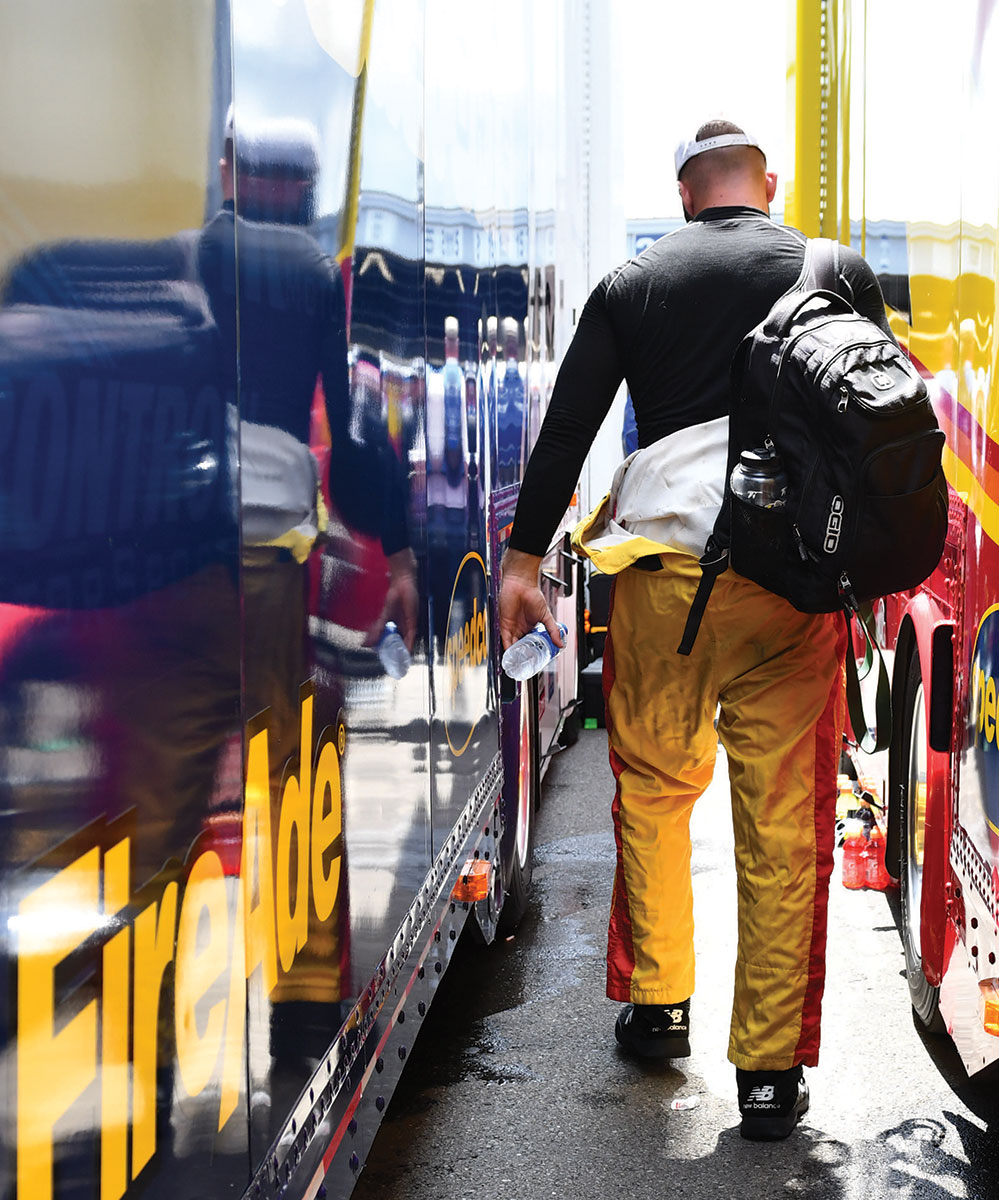
By Kevin M. Burke
Photos by James Burke
He understands the physics of it better than most. A dozen times or more during some of the longer races on the NASCAR Monster Energy Cup race schedule, Brook Davenport, B.S.M.E. 2018, lugs his gas can over the wall along pit road while a 3,400-pound racecar rushes toward him at up to 55 miles per hour. The combined energy of mass and momentum is enormous, and dangerous.
“It happens a lot, people getting hit on pit road, especially with young drivers who don’t have a lot of experience with live pit stops,” acknowledges Davenport, completing his first year as a quality control engineer and race weekend pit crew member with Chip Ganassi Racing.
“The first time I did it [a live pit stop] in a race was at Daytona. You have 40 other cars coming down pit road and you have to pick out your car, and you’ve got the spotter and the crew chief in your ear telling you what you’ve got to do. To be honest, I don’t really remember much. A lot of the guys after the stop were like, ‘Good job for your first one.’ But I can’t tell you anything that happened. I just kind of went blank.”
As his team’s gas man, Davenport’s responsibility is to fuel the racecar’s tank — up to 18 gallons at a rate of two gallons per second — while the other four crew members change four tires. An optimum stop takes 12 to 13 seconds, a feat of athletic precision it took Davenport eight months of training to master before finally earning his place trackside.
On most companion weekends, when the Xfinity and Monster Energy series — basically, the junior varsity and varsity levels of the sport — run events at the same track, Davenport will pit both races, and sometimes even three if there’s also a truck race. Past the halfway point of this year’s NASCAR season, he’s managed to stay out of harm’s way, says Davenport, looking for a place to knock wood inside his team’s hauler, the tractor trailer that transports the team’s racecars and equipment to every track and serves as the crew members’ home away from home.
So, what makes a cum laude graduate with a degree in mechanical engineering forego an already-lined-up, after-graduation engineering job in D.C., relocate to Charlotte, move furniture and valet cars to cover the rent while practicing without pay on a pit crew four to five times a week for eight months with only a slim hope of finding a permanent spot with the team?
Well, if you do manage to make it, the money is pretty good as starting salaries go — $80,000 to $120,000 a year, according to a NASCAR official quoted in a 2018 feature story in The New York Times. With a few years of experience, pit crew superstars can make anywhere from $150,000 to $200,000 a year.
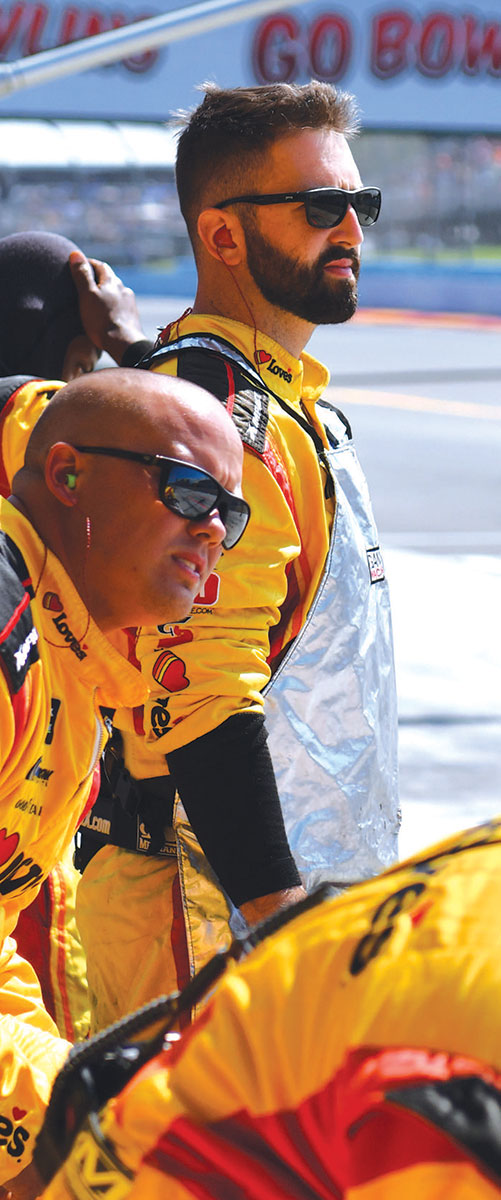
Davenport, a former offensive lineman on the Cardinals football team, had a different motivation.
“I wanted to continue my athletic career and I knew the NFL wasn’t going to be the way to do it, and this was another option for me to be a professional athlete. But also pursue what my degree was in,” says Davenport, who completed two internships in engineering while a student.
“My job revolves around fractions of a second between a win and a loss, so if I can find a way to dump a gallon of fuel maybe a quarter-second faster than another team can, it could translate to multiple positions gained come the end of the race. Problem solving and equipment optimization is a huge part of the sport, just as it is in engineering.
“So, this was kind of the best of both worlds between athletics and engineering. And the Division III aspect of emphasizing academics and athletics … I think that’s why I rolled so well into this, because of the balance of both.”
The smoke and smell of grilling steaks begin to fill the garage area of Watkins Glen International in Upstate New York several hours prior to the 3 p.m. start of the Aug. 4 Go Bowling Monster Energy Cup race. There are no vegetarians in NASCAR, laughs Davenport, at least not among the mechanics, jack men, tire carriers, tire changers, and gas men that get each car to the starting line and keep it on track. (Although references to “jack men” and “gas men” are still common in and around the pits, women integrated this once exclusively male workplace starting in 2018.) Here, where each wheel and tire assembly weighs 50 pounds or more and a 12-gallon fuel can full of gas weighs 94, muscle fueling protein is the order of the day. NASCAR crews eat well.
And some better than others. Davenport retells a story when celebrity chef Guy Fieri cooked for a rival team during a July race weekend in Sonoma, Calif. Even weeks later, the episode remained a topic of good-natured ribbing between some of the crews.
“It’s not like everyone thinks, that we don’t get along with the RCR [Richard Childress Racing] or Hendrick guys. It’s not like that. You’re with them the same amount of time you’re with your own team in every single city for 40 weeks, so you just make it work. We’re all friends,” Davenport says. “You definitely want to beat them on pit road, and when your car beats another guy out you’ll see them shooting at each other with [finger] pistols, like teasing and stuff. But it’s all a brotherhood. There’s a lot of respect.”
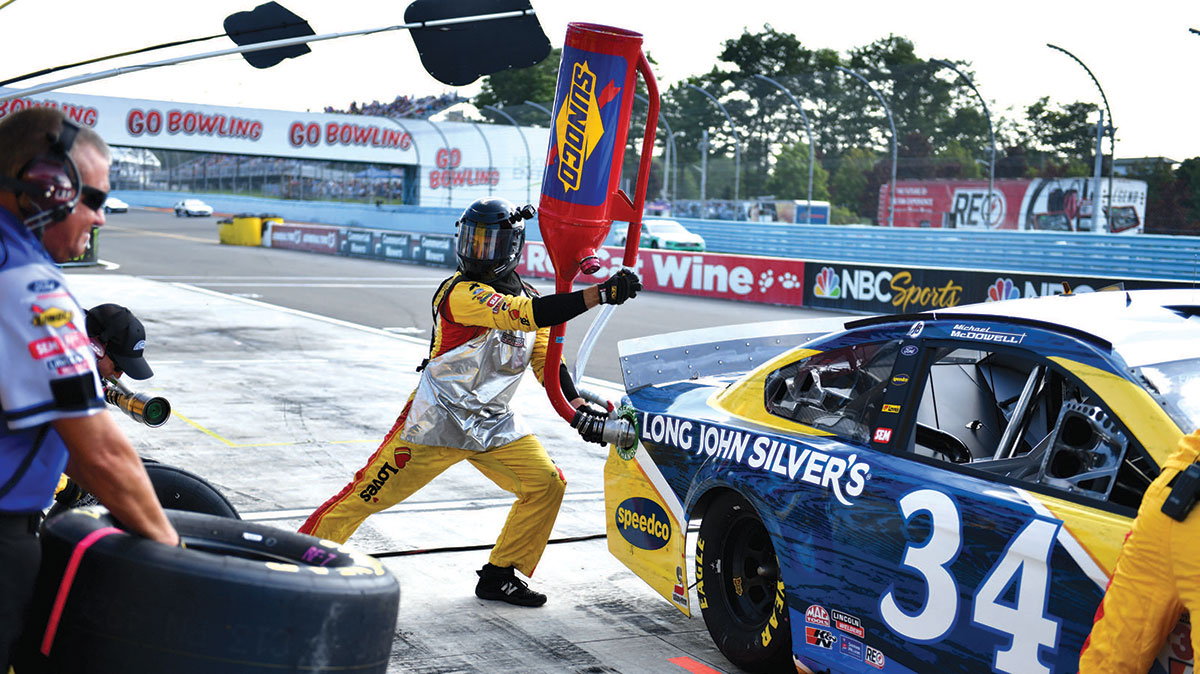
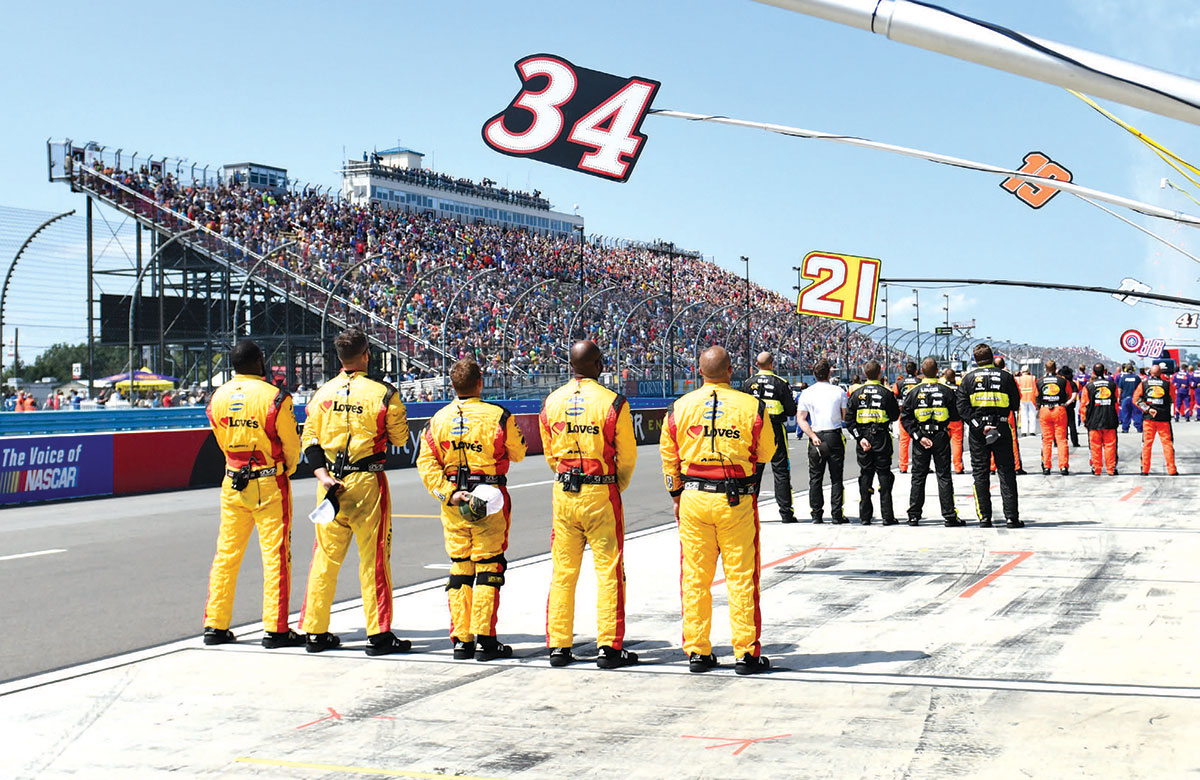
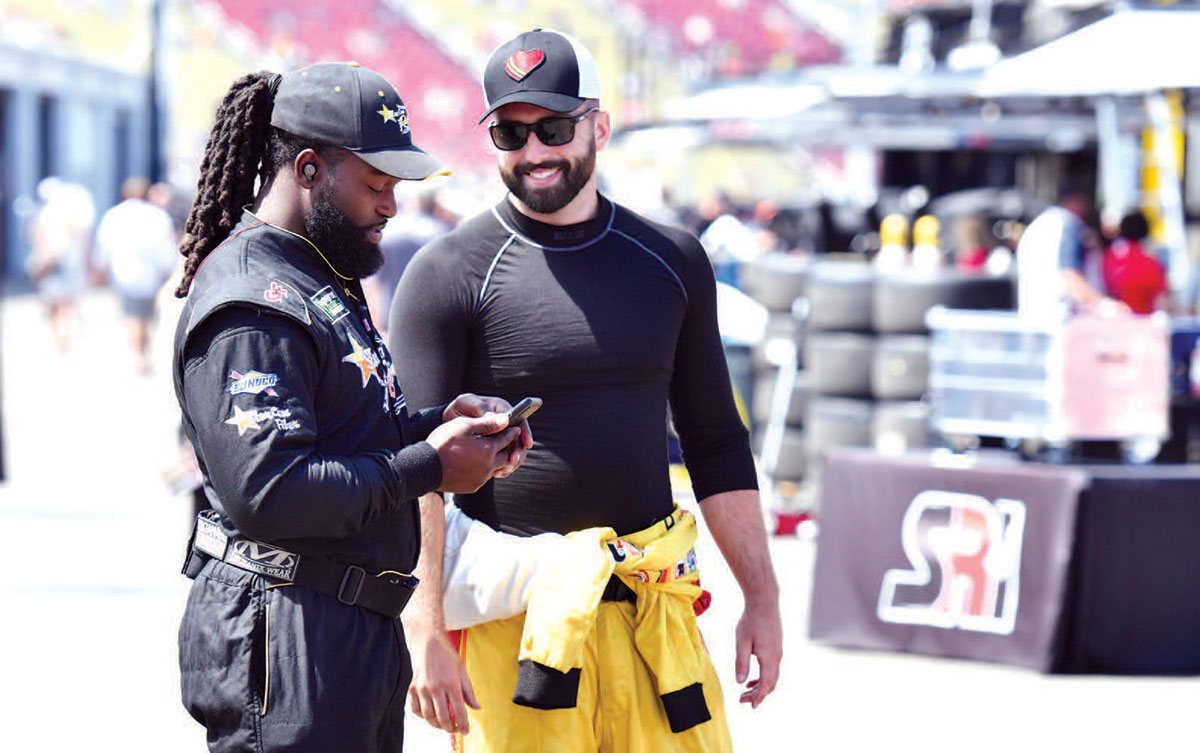
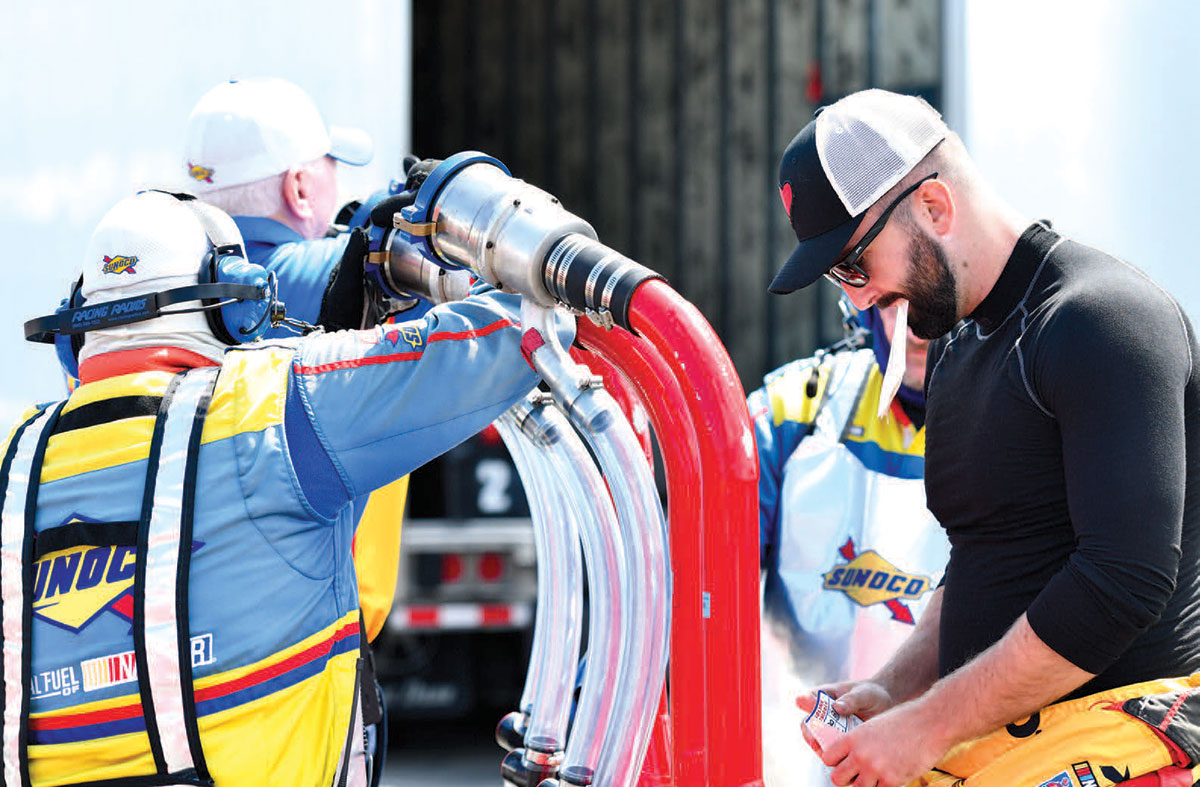
Adding to the camaraderie is that about 80 percent — by Davenport’s estimation — of the crew members along pit road are former pro or college athletes, most of them football players who came up through Division I or I-AA schools. Davenport and one of his Ganassi teammates who played college ball at tiny Hampden-Sydney College in Virginia are rare representatives of Division III.
In his final year playing football for the Cardinals, Davenport brought 280 pounds to his position at offensive tackle. Today, his 6’-5” frame is down to a less bulky 228, the better to perform the intricate and uniquely challenging choreography required to change four tires and dump 18 gallons of fuel in a little under 13 seconds. Just “trying to stay out of everyone’s way” is key to the process, says Davenport, who has learned the perennial adage in racing that no one in the pits is going to win a race, but they can lose one.
“There’s nothing the fuel man can do to speed up your stop; you can only slow it down,” he says. “So you’re just trying to get in and out and get it full.
“The big thing is practice. It’s a lot more working gears than you would think, and it’s just coming together as a group and meshing. It happens on the practice pad outside during the week. It happens in the weight room. Just knowing each other’s choreography … you know, some people lean more than others. Yeah, practice is huge.” That kind of commitment and get-it-done attitude comes as no surprise to Catholic University Head Football Coach Mike Gutelius, who says Davenport, then a senior, was not only a great help to him personally as he took over the Cardinals’ helm in 2017, but also an outstanding example of leadership for younger players on the team.
“Tremendous work ethic. He never missed a workout. Early to practice. Stayed late,” recounts Gutelius, giving a lot of credit to Brook’s parents, Tracy and Mike, both former college rowers at Florida Tech. (Mike, recently retired as head women’s rowing coach at Washington College, also was a coach with the 1996 U.S. Olympic rowing team, and today Tracy, who holds a doctorate in human growth and development, runs her own company helping athletes and coaches reach their peak performance.)
“You know, that year we took a squad that was not necessarily overly talented, and we fought through some quarterback changes, and we still went 5-and-5 to have the best record in quite a few years,” continues Gutelius. “That was strictly on the drive of those seniors, and Brook was right out front. He led that offensive line, and they were going to get better no matter what, by sheer will alone. And now it looks like he’s kind of carried that on.”
After more than 20 years of coaching, Gutelius is pleased and proud that Davenport turned out to be his first professional athlete — even if in a sport other than football.
“I didn’t get to recruit Brook. I wish I could put that feather in my cap, but he was already here,” says Gutelius. “But, he’s what I want, and what I have a vision of that I want going out the door … guys like Brook. Guys that take from the football experience of learning about teamwork, and discipline, and focus, and being relentless, and being a leader. That’s translated well for him. I’m so excited for his success, and that’s what I want for our players. When those guys walk out the door who played football here, if they’re like Brook, then we’re doing a good job."
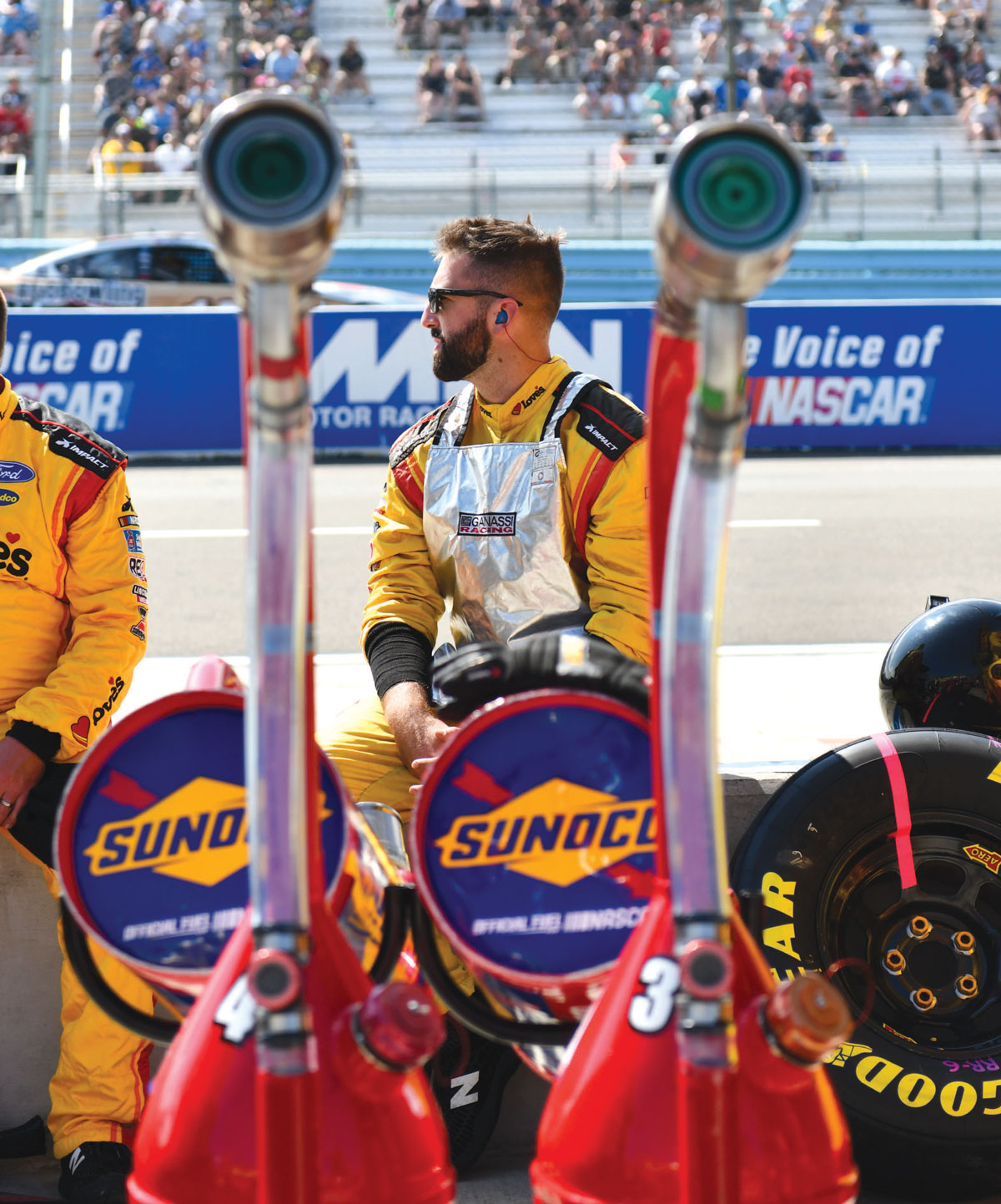
For all the obvious differences, Davenport still believes there are a lot of similarities between his experience playing football and his new athletic endeavors.
For example, like his time on the offensive line, when he was part of a cohesive and coordinated five-man unit helping to advance the ball, he’s now part of a five-man pit crew working together to help its driver maintain or improve his track position.
Also just like football, when the real action usually takes place in short spurts of six or seven seconds, each pit stop is also a concentrated burst of energy, albeit lasting a slightly longer 12 or 13 seconds.
And just as in football, each team spends hours away from the track watching video (each crew member wears a small camera attached to his helmet) trying to isolate mistakes and find improvements that might speed up stops. One of Davenport’s particular pre-race tricks of the trade is treating the dispenser end of each of his gas cans, known as a Schultz head, with a commercial nonstick cooking spray. The extra lubricant where the gas can and filler tube on the racecar meet can help avoid the costly penalty, not to mention embarrassment, associated with having a driver pull away with a gas can still sticking out of the rear quarter panel.
“So, when you look at it like that, it’s very similar to many aspects of football,” Davenport says.
On the other hand …
Imagine shouldering a 100-pound weight and then attempting anything requiring speed and agility or, really, anything. You’re about to get a quick and possibly harsh lesson regarding center of gravity, which has suddenly moved from more or less around your navel to somewhere in your upper chest. Allow that kind of weight to get moving uncontrolled and bad things are the almost certain result. Such is the test Davenport faces during each pit stop.
“It’s such a weird movement,” he says; he has singular admiration for the tire changers, who do most of their heavy lifting from their knees. “So the transition from those more normal, sort of side-to-side movements, it just takes such a long time to progress to the unnatural but very athletic movement that you see on pit road.”
The “unnaturalness” of the sport doesn’t end there. Take the travel, which Davenport professes to love, but which also can have profound effects on relationships — Q: What does your girlfriend think about what you’re doing? A: “She thinks I’m gone a lot” — and normal perceptions of time and space.
“There are times when you wake up and you’re not really sure where you are and you have to check Google Maps to see what city you’re in. It’s kind of freaky.” During the 40-week race season, Davenport says he probably spends as much time living in hotels as in his Charlotte apartment.
And then there’s the strange tension between celebrity, anonymity, and the fans that crew members encounter at each stop on the schedule. When they go out to dinner in different cities, Davenport says, he and his teammates purposely do not wear team-branded attire, because fans inevitably will approach them looking for the inside story, autographs, souvenirs, and even an introduction to one of the drivers. All of which reflects the celebrity status that NASCAR continues to enjoy within certain areas of American popular culture.
But that’s the TV-promoted view of the sport, says Davenport, and many times it contrasts sharply with actual life in the pits. When it comes time to suit up before a race, for example, most crew members find a relatively concealed place between the closely parked haulers in the garage area or — in Davenport’s case before the Watkins Glen race — an out-of-the-way spot next to an infield storage shed, with a blanket thrown over a nearby fence for a modicum of privacy.
In all, though, Davenport believes, “It’s the best job ever. I love it. There’s pressure, but the pressure’s fun. That’s what makes it a fun job.”
How long he’ll be able to continue in his weekend job is an open question, however, and Davenport understands that.
“I want to pit as long as I can,” he says. “But, eventually, like with any professional sport, you can’t play the sport any longer. It’s just … you’re going to get too old to carry a fuel can. So, eventually I think I will move more to the engineering side.”
When not training or practicing during the week, Davenport already works in the Ganassi shop testing parts and learning all he can about suspension systems, set-ups, and design techniques.
“The sport evolves so quickly. If you think back, just a few years ago there were six or seven guys going over the wall; now it’s down to five,” says Davenport. “They’re trying to get people off pit road — safety reasons; money reasons. So you’ve always got to be ready for the next step, and I’m really blessed to have an engineering degree from Catholic because that knowledge has prepared me for where I think the sport is going.”
That gratitude to the University for Brook’s educational experience is shared by his parents, who watch “every minute of every race” their son pits.
“I once heard Tom Brady say his parents never once told him he couldn’t or shouldn’t. That’s the way I feel about Catholic University,” says Tracy Davenport, speaking from the family’s home in Centreville, Md.
“Did Brook tell you that he told the college interviewer at Catholic his plans [to one-day pit racecars] and he said, ‘Wow, that’s really cool.’ And never once was Brook discouraged in his dream by the engineering department. They supported him around every corner ... a kid from the country, a Quaker, and someone who dreamed of NASCAR of all things.
“I will always be grateful and amazed at their openness to support him in this journey.”